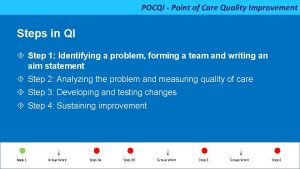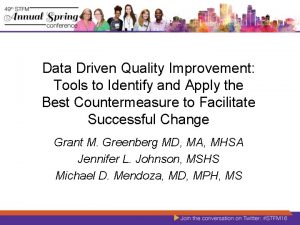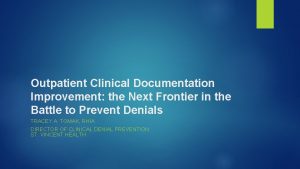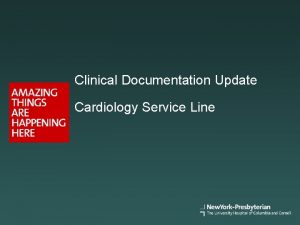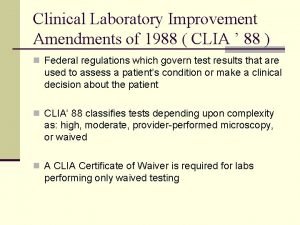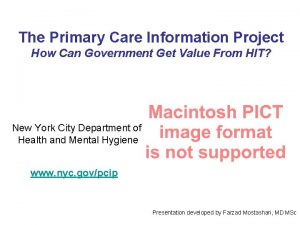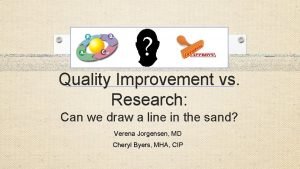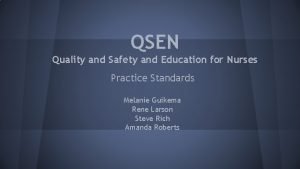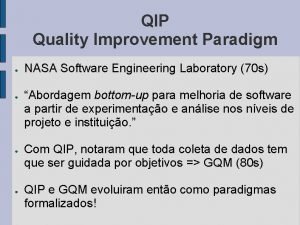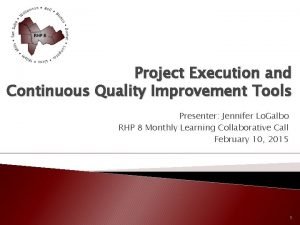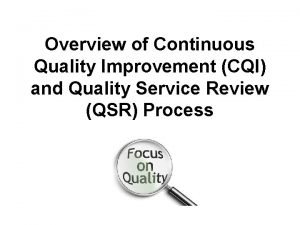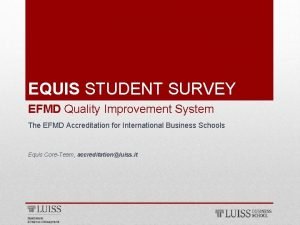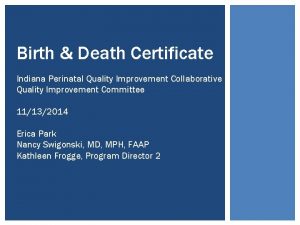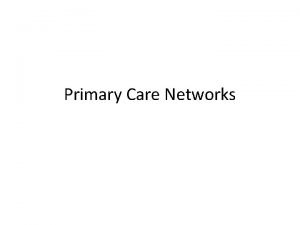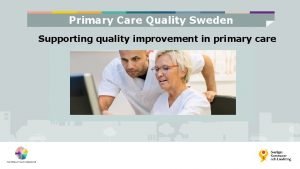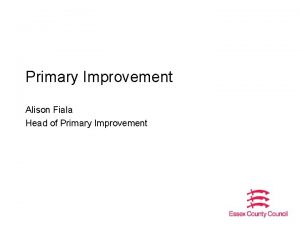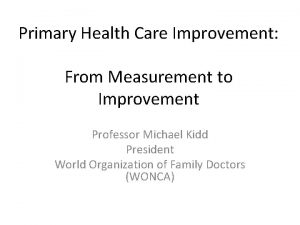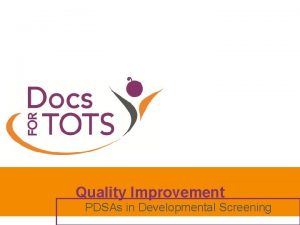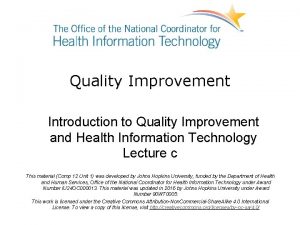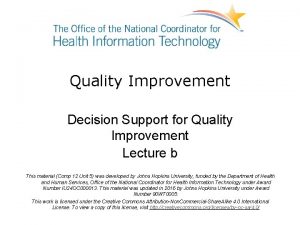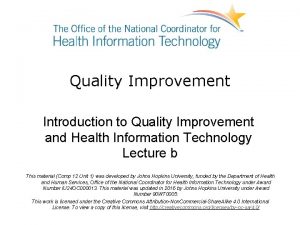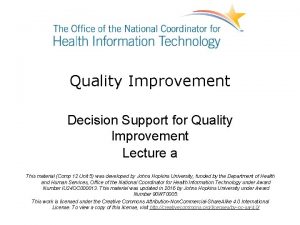Primary Care Data Quality Improvement Project Clinical Working
















- Slides: 16

Primary Care Data Quality Improvement Project Clinical Working Group Web Meeting April 30 2020 Meeting Hygiene Recording Mute please Discussion Questions Keep to time Follow-up this presentation so others can watch later Recording for audio quality; the mute button is here “wave” if you need to contribute immediately post in “chat” here; we will moderate & answer everyone has time constraints unfinished business and Q&A will be posted here https: //confluence. csiro. au/x/h. ASLS

Agenda Updates on • Ethnicity • Language, Communication • Country of birth • Family History • Smoking • Alcohol • Other substance use New developments for SDOH • Reusable sub models § § § • • • Patient Concern List Issue/Recommendation List Goal List Intervention List Screening tools Mood and Wellbeing Food Security Nutrition Housing Physical Activity Family and Social Connection Gambling Learning and Education Employment and Finances (Occupation now in Demographics) Legal and Safety Transport Work in progress data model http: //clinfhir. com/logical. Modeller. html#svass

Design considerations Keep in mind… • Not all data elements are mandatory, some are conditional or optional • Not all data elements need to be considered for every Patient, every visit • Some elements have been specified in common core (demographics for eg) because these are used for broader clinical care not just health assessments or screening • Places for existing data to land in a questionnaire (auto-populate from clinical record) • Places for new data to be collected (and written back to clinical record) • Re-usable, predictable sub-models that can produce consolidated lists • Data structures for use and re-use; ‘under-the-hood’ not Clinician or Patient-facing • Questionnaire interface will look different and behave quite differently

Demographics Family History Health behaviours

Ethnicity • • • Needed for risk assessment algorithms Patient identified Ethnic Group May be multiple Often confused and conflated Value Set: 1249. 0 - Australian Standard Classification of Cultural and Ethnic Groups (ASCCEG), 2016. May need supplementary codes for clinical purposes Will include “Unknown” for adoptees Advice and contributions please Model Language and communication Country of birth Family history Smoking Alcohol Other substance use

Ethnicity Language and communication Country of birth Family history Smoking Alcohol Other substance use Language and Communication • Not just about § need for interpreters § sign language § pamphlets/guidance in other languages • Also about literacy and health literacy of the Patient § in their native language, in English or either/both § copies/extracts of assessment and plans given to the Patient need to be Patient-appropriate • Value Set includes Interpreter needed, literacy problems, fully literate, complete deafness, deaf telephone user, numeracy levels (important for med dosage) Preferred contact details and NOK emergency contact is a separate data element Model

Ethnicity Language and communication Country of birth • Distinct from Ethnicity • Added Parent Country of Birth § Clinically relevant vertical transmission of Dx (eg: Hep B)* § Patient and parents may or may not have different birth places § Multiples allowed; “Unknown” allowed for adoptees Once documented won’t change Use ABS standard vocabulary for Value Set? 1269. 0 - Standard Australian Classification of Countries (SACC), 2016 * Clin Ther. 2018 Aug; 40(8): 1255 -1267. doi: 10. 1016/j. clinthera. 2018. 05. 016. Epub 2018 Jul 5. Elimination of Vertical Transmission of Hepatitis B in Africa: A Review of Available Tools and New Opportunities. https: //www. health. gov. au/resources/pregnancy-care-guidelines/part-f-routine-maternal-health-tests/hepatitis-b “First-generation immigrants usually retain the carrier rate of their country of origin (Mast et al 2004)” Model Family history Smoking Alcohol Other substance use

Ethnicity Language and communication Country of birth Family history Smoking Alcohol Other substance use Family history • Allows for Relationships, Dx, age at onset, cause of death, age at death • Repeatable cluster per Relationship • Allows no significant family history and date last updated • Maximal codeable Value Set to serve multiple uses (not just ‘standard’ health priority Dx; allows screening, risk assessment, preventive care) • Data elements can be (re)used in pedigree drawing tools Model

Ethnicity Language and communication Country of birth Family history Smoking Alcohol Health behaviours, Tobacco • • Status determines additional information/documentation – conditional Types of tobacco, Typical use patterns, Typical Units, Quit attempts Auto-calculate overall pack years Readiness to change smoking behaviour Quit date Value Sets developed (cigars, cigarettes, pipe) Free text descriptions allowed Model Other substance use

Ethnicity Language and communication Country of birth Family history Smoking Alcohol Health behaviours, Alcohol • Status determines additional information/documentation – conditional • Standard drinks, Drinking pattern/Frequency, Binge drinking behaviour, Typical Units, Alcohol-free-days, Quit attempts • Readiness to change drinking behaviour • Quit date • Reflects AUDIT-C; data element for AUDIT-C assessment results to be stored • Free text descriptions allowed Model Other substance use

Ethnicity Language and communication Country of birth Family history Smoking Alcohol Other substance use Health behaviours, Other substance use • • • Status determines additional information/documentation – conditional Type of substance, Method of use, Pattern of use, Quit attempts Readiness to change substance use behaviour Quit date Value Sets to be developed (should only be substances? not dependence/abuse? not street names? ) Free text descriptions allowed Model

Social Determinants of Health (SDOH)

Caveats to start with • Initial goal of this model is to enable the collection of ‘Issue’ information • The data model is not the questionnaire Rather it is where in a backend system that the data will ‘land’ or be stored • Model doesn’t contain all accompanying info like dates, and attestation information But it will in final form • Datatypes are not ‘pure’ (yet) • Not intended to automatically populate a FHIR Implementation guide Model

Next Steps

Next Steps • Submit feedback on items discussed today – by 14 th May to Primary. Care. Data. Quality@csiro. au • Feedback will be reviewed and incorporated before the next meeting

Next Meetings Meeting Date Time Draft agenda 2 Thursday 21 st. May 12 pm-1. 30 pm Update on work done for data dictionary 3 Thursday 11 th. June 12 pm-1. 30 pm Updates from feedback from meeting 1 Examinations and observations Final update and wrap up of Phase 2
 Primary secondary tertiary care nursing
Primary secondary tertiary care nursing Define seminar in nursing management
Define seminar in nursing management Compliance vs quality
Compliance vs quality Pocqi ppt
Pocqi ppt Data driven quality
Data driven quality Hip fracture clinical care standard
Hip fracture clinical care standard Outpatient clinical documentation improvement
Outpatient clinical documentation improvement Clinical documentation improvement for cardiology
Clinical documentation improvement for cardiology Clia'88
Clia'88 Primary care information project
Primary care information project Quality improvement vs research
Quality improvement vs research Qsen examples in nursing
Qsen examples in nursing Quality improvement paradigm
Quality improvement paradigm Continuous quality improvement plan example
Continuous quality improvement plan example Define continuous quality improvement
Define continuous quality improvement Efmd quality improvement system
Efmd quality improvement system Indiana perinatal quality improvement collaborative
Indiana perinatal quality improvement collaborative



